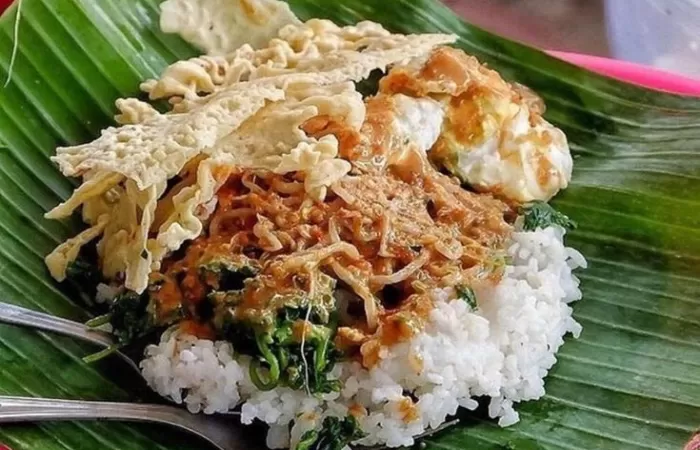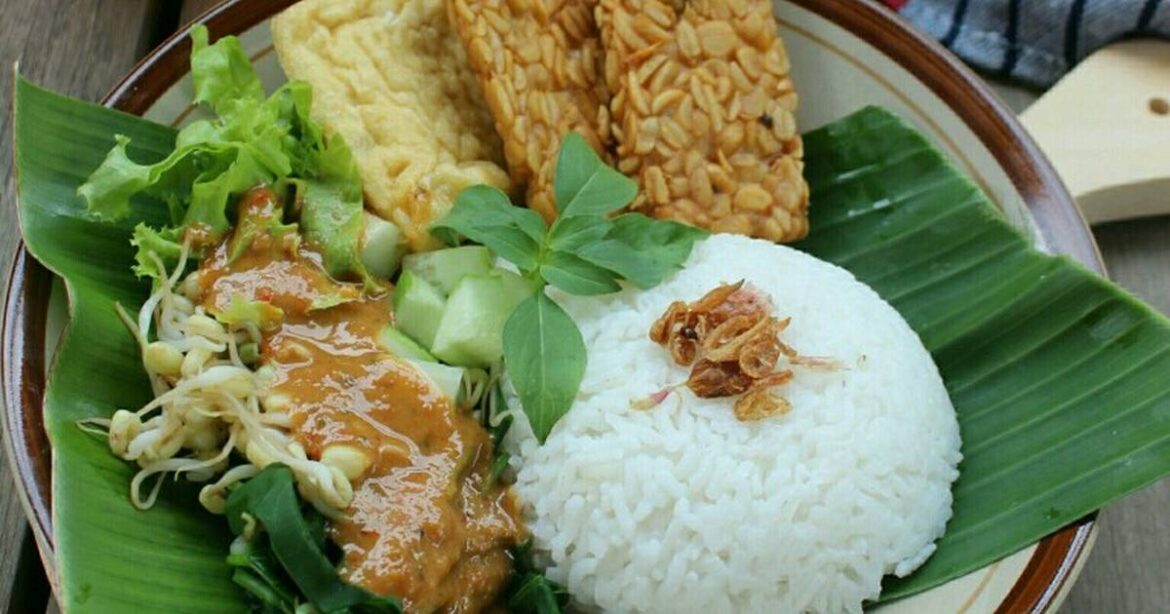The Story Behind the Spice
Nasi Pecel is arguably the most democratic of Indonesian dishes. It is a simple, nutritious meal of steamed rice, boiled vegetables, and a generous coating of peanut sauce. While variations exist across Java, the Nasi Pecel from Blitar—a city steeped in history as the resting place of Indonesia’s first President, Sukarno—holds a special place.
Pecel itself has a long lineage, mentioned in the $12^{th}$-century Babad Tanah Jawi (Chronicle of the Land of Java) and often served as a royal banquet dish. In Blitar, the dish became a symbol of local pride, famously loved by Bung Karno for its simple perfection.

Blitar vs. The World: The Kencur Factor
While Pecel Madiun is well-known for its slight sweetness and the intense aroma of kaffir lime leaves, Pecel Blitar distinguishes itself with a few key characteristics:
- The Kencur (Aromatic Ginger) Kick: This is the soul of Blitar Pecel. The local peanut sauce uses a significant amount of fresh kencur, which gives the sauce a refreshing, slightly medicinal, and uniquely aromatic flavour that is distinct from its Madiun counterpart.
- Texture and Spice: The peanut sauce is typically ground to a smoother texture and often carries a bolder level of heat (pedas), balancing the sweetness from the palm sugar beautifully.
- The Toppings: Pecel Blitar is traditionally served with a flourish of crunchy Serundeng (Sweet Grated Coconut) and, of course, the crispy, savory crunch of Peyek (Peanut or Shrimp Cracker). The usual side dishes include deep-fried tempeh or tofu.
The result is a peanut sauce that is smooth, hot, aromatic, and deeply savory—a perfect marriage with the fresh greens of East Java.
Authentic Nasi Pecel Blitar Recipe
This recipe is divided into two parts: making the legendary Sambal Pecel (Peanut Sauce) and assembling the final dish.
Part 1: Sambal Pecel Blitar (Peanut Sauce)
This paste can be made in large batches and stored in the refrigerator or freezer for months.
Ingredients
| Ingredient | Quantity | Notes |
| Kacang Tanah (Raw Peanuts) | $250$g | Shelled and skinned (or simply rinse well if using skin-on) |
| Gula Merah (Palm Sugar) | $150$g | Finely sliced or grated (Adjust to taste) |
| Bawang Putih (Garlic) | $3$ cloves | |
| Cabai Merah Keriting (Curly Red Chillies) | $5$ pcs | Adjust according to preferred heat level |
| Cabai Rawit (Bird’s Eye Chillies) | $5-10$ pcs | For extra spiciness |
| Kencur (Aromatic Ginger) | $2$ cm chunk | The key Blitar ingredient |
| Daun Jeruk (Kaffir Lime Leaves) | $5$ leaves | Remove the center vein |
| Asam Jawa (Tamarind Pulp) | $1/2$ tsp | Mixed with $1$ Tbsp warm water |
| Garam (Salt) | $1$ tsp | To taste |
Instructions: Sambal Pecel Paste
- Roast or Fry Peanuts: Pan-roast the peanuts over medium heat until golden brown, stirring continuously (or deep-fry briefly). Drain and let cool completely.
- Prepare the Spices: Lightly fry or toast the garlic, red chillies, and kencur for a minute or two. This mellows the raw flavor and enhances the aroma.
- Grind the Bumbu: Using a food processor, or traditionally, a stone mortar and pestle (cobek):
- First, grind the fried/toasted spices (Garlic, Chillies, Kencur, Daun Jeruk, Salt, and Tamarind paste) until a coarse paste forms.
- Add the sliced Palm Sugar and continue grinding until fully incorporated and smooth.
- Finally, add the cooled Peanuts. Grind or process until the peanuts are smooth and the mixture is thick, oily, and homogenous.
- Store: Press the finished Sambal Pecel into a block. It is now ready to use or store in an airtight container in the fridge for up to a month.
Part 2: Assembling Nasi Pecel Blitar
Main Ingredients
| Ingredient | Quantity | Preparation |
| Nasi Putih (Steamed Rice) | $4$ servings | Served warm |
| Bayam (Spinach) | $1$ bunch | Blanched/boiled briefly |
| Kacang Panjang (Long Beans) | $1$ bunch | Cut into $3$cm pieces, blanched/boiled |
| Tauge (Bean Sprouts) | $100$g | Blanched/boiled briefly |
| Kol (Cabbage) | $1/4$ head | Sliced, blanched/boiled |
| Timun (Cucumber) | $1/2$ piece | Sliced (optional, for crunch) |
Traditional Complements (Lauk Pauk)
- Tempe or Tahu Goreng (Deep-fried Tofu or Tempeh)
- Serundeng (Sweet-savory grated coconut topping)
- Rempeyek Kacang or Udang (Peanut or Shrimp Crispy Crackers)
- Sate Jeroan (Skewer of chicken liver, gizzard, or quail eggs)
Assembly Instructions
- Prepare the Sauce: Take about $3$ tablespoons of the Sambal Pecel paste and mix it with about $100$ml of warm water in a bowl. Stir well until the sauce is creamy and easily pourable, but still thick (medok). Adjust the thickness by adding more water or paste as needed.
- Plate the Rice: Place a scoop of warm rice on a plate, or traditionally, on a Pincuk (a cone-shaped dish made from a banana leaf).
- Arrange the Vegetables: Neatly arrange small portions of the boiled spinach, long beans, bean sprouts, and cabbage around the rice. Add a few slices of fresh cucumber.
- The Grand Finale: Drizzle a generous amount of the prepared Pecel Sauce over the vegetables and slightly over the rice.
- Garnish: Sprinkle with a spoonful of Serundeng and place the complements on the side (Tofu, Tempeh, and a large Peyek).
Serve immediately and enjoy the authentic taste of Blitar! The fresh, earthy aroma of kencur should transport you straight to the heart of East Java.


Leave a Reply